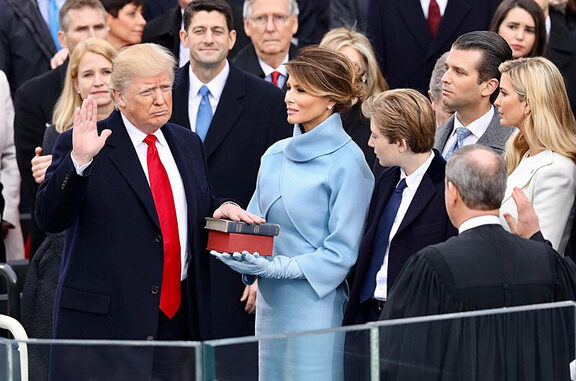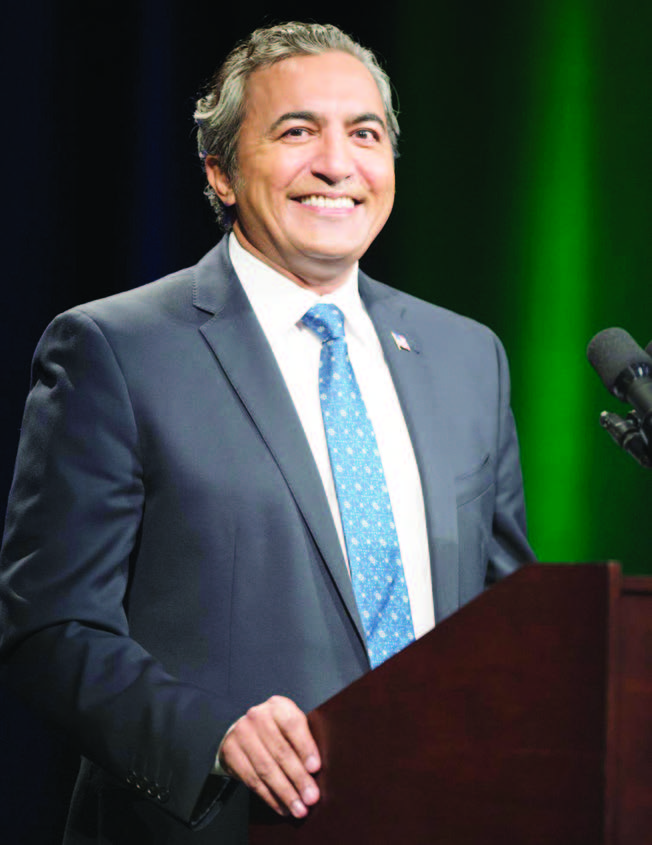
- How will the world, and India, negotiate Trump 2.0?
- Why is Trump threatening punitive tariffs on some countries?
- Will he usher in changes in immigration policies?
- Will his second term also likely witness America’s continuing withdrawal from global, multilateral and regional engagement?

When U.S. President-elect Donald Trump is administered the oath of office on January 20, 2025, and officially kicks off his second term at the White House, it will be the onset of four years that herald the deepening of domestic and foreign policy priorities enacted in his first term as President. On the cards are a reimposition of punitive tariffs against nations exporting to the U.S., and India is likely to feature on that list; a tough stance on immigration; and changes in foreign policy, with America likely to see the continuing withdrawal from global, multilateral and regional engagement like in his first term.
What tariffs policies and tax cuts are likely to be tabled by the Trump administration?
The first Trump administration started a trade war with China when it hit Beijing in 2018 with a punitive net tariff coverage of nearly 15% of all U.S. imports. In that case, his administration had already imposed several tariffs prior to 2018 as well, with the result that there were overlapping tariffs on a number of products; for example, the 25% tariff that was imposed that year was over and above an antidumping tariff of approximately 66% that was already in place. Despite this somewhat chaotic approach to tariff imposition, one fact was clear — China was the main target on the global stage: at 11.1% import coverage by U.S. special tariffs in 2018, the rate slapped on Beijing dwarfed the rate for other exporters to the U.S., including India, at 0.2%. In terms of products, the U.S. special tariffs preponderantly targeted imports of intermediate goods, and to a much lesser extent capital goods and final products. This is likely to have impacted the final price of finished goods based on intermediate goods sourced within the U.S.
During his 2024 campaign, Mr. Trump had affirmed that he would impose an across-the-board tariff of somewhere between 10%-20% on the entire $3 trillion worth of U.S. goods imports and a China-specific additional tariff of 60%. Assuming that the focus on intermediate goods continues in this context, this would imply a significant jump from his first term in terms of the value of goods impacted, most likely additional tens of billions of dollars’ worth on commodities such as steel and aluminum and at least $300 billion worth of Chinese goods. Retaliation from China, the E.U., India, and other trading partners of the U.S. is sure to follow swiftly.
Regarding the high likelihood of a corporate tax cut, it could come in the form of renewing the lapsing cuts that Mr. Trump had introduced in 2017, through the Tax Cuts and Jobs Act. This despite — or perhaps precisely because of — the fact that the policy did reduce taxes for most people, though it disproportionately benefited the wealthy, according to the non-partisan Center on Budget and Policy Priorities. Their analysis at the time noted this policy resulted in households with incomes in the top 1% receiving an average tax cut of more than $60,000 if the cuts were maintained, compared to an average tax cut of less than $500 for households in the bottom 60%. Additionally, the Trump tax cut “was expensive and eroded the U.S. revenue base… and failed to deliver promised economic benefits,” the CBPP noted.
Other economic policy actions that the Trump White House might advocate for include a carbon-border adjustment tax and quantitative restrictions on investments into U.S. assets such as infrastructure and essential medicine production capabilities, by China.
His administration would also likely seek the inputs of the Department of Government Efficiency — led by the “tech bros” Elon Musk and Vivek Ramaswamy — to reduce wastage and inefficiencies within the purview of the federal government, including by rationalizing the actions of bureaucrats and cutting down on regulations across sectors. While the duo has hinted at potentially finding $2 trillion in savings through this initiative, including via mass layoffs and the shutting down of some agencies entirely, critics have challenged the size of the potential gains that could be made here.
What action is expected on immigration?
Going by the Trump campaign’s policy promises in the lead-up to the 2024 election, there is a distinct possibility of a large-scale deportation of undocumented workers. However, there may be several obstacles that the White House might encounter as it carries out this possibly unprecedented action. Firstly, across several states, key urban hubs have vowed to be “sanctuary cities” and pass laws to limit local law enforcement cooperation with the federal government’s Immigration and Customs Enforcement. This is likely to make it politically complicated to carry out detention and deportation actions on a sizeable scale and in a short time frame. Secondly, the Trump campaign is yet to share details on the cost of such operations to the exchequer, but non-partisan analysts such as the American Immigration Council estimate that such an immigration proposal could potentially cost taxpayers considerably more than $300 billion. These estimates notwithstanding, there is little doubt that Mr. Trump will attempt to accelerate deportations to fulfil his campaign promises, especially as the first Trump administration deported close to 1.5 million people – almost the same number as outgoing President Joe Biden and far less than former President Barack Obama, who turned away nearly 3 million people over eight years in office.
What impact could be expected regarding U.S. foreign policy?
Mr. Trump has proclaimed publicly without explanation or details that he can and will end the Russia-Ukraine war and the Israel-Hamas conflict. On the former, he has said he would end the war even prior to Inauguration Day, even if he views the conflict through the lens of halting the “endless flow of American treasure to Ukraine” and demanding that NATO allies in Europe reimburse Washington for its war-related expenses if they expect military support from the U.S. against future Russian aggression.
Regarding Israel, the incoming President has followed in Mr. Biden’s footsteps and criticized the Israeli government’s aggression in Gaza, although Mr. Trump had tacitly expressed support for Israel by moving the U.S. embassy from Tel Aviv to Jerusalem in his first term.
What bolsters Mr. Trump’s intentions?
While the Trump 2.0 administration is yet to spell out critical details regarding its policy plans on the domestic and international fronts, one thing is certain: Mr. Trump enjoys an overwhelming mandate expressed through the result of the 2024 election. Further, he will be fundamentally operating from a position of institutional strength given the federal government trifecta, which implies that the White House will enjoy the luxury of greater cooperation in getting policies sanctioned by Congress, and possibly important cases ruled in his administration’s favor by a sympathetic U.S. Supreme Court.
(The author is Opinion editor at The Hindu)





699548 807281Good day! This post could not be written any much better! Reading this post reminds me of my previous room mate! He always kept chatting about this. I will forward this write-up to him. Fairly certain he will have a good read. Thanks for sharing! 924037